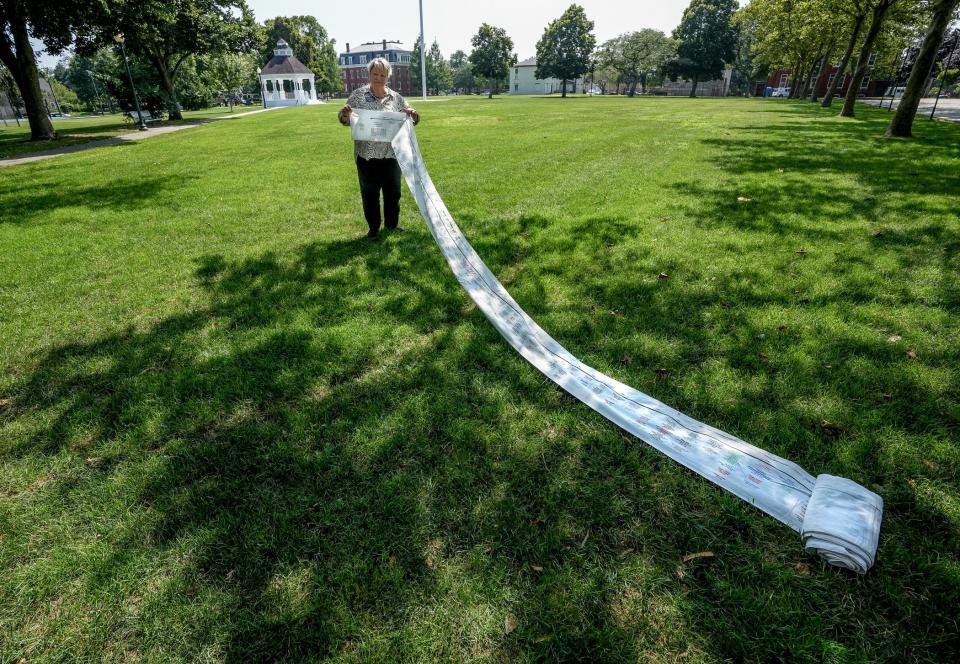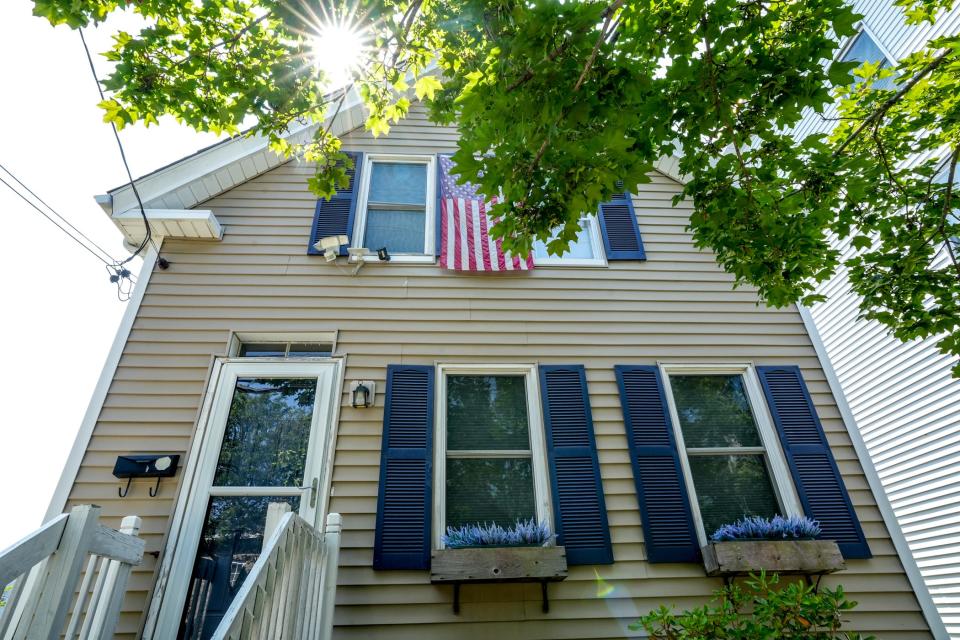Shedding light on the little-known history of New Goree, Bristol's free Black neighborhood
BRISTOL – As she crosses the Town Common and makes her way up Wood Street, Lynn Smith points out one church after another.
There's the First Baptist Church, where you'll find the White Anglo-Saxon Protestants (WASPs). Our Lady of Mt. Carmel, built to serve Italian immigrants. St. Mary's, historically an Irish parish. Then, a few blocks away, there's St. Elizabeth, which caters to the Portuguese community.
What's missing, she points out, is the Black church.
Around the early 1800s, free Black residents of Bristol began moving to Wood Street, where they formed a neighborhood known as "New Goree." But by the early 1900s, that community had all but vanished, and few traces of it remain today. Where the African Methodist Episcopal church once stood, you'll now find the Bristol Sports Club, its boxy façade bedecked with a Portuguese flag.
"It's hiding in plain sight," Smith says.

Walking around Bristol, it’s easy to be reminded of the town’s Yankee heritage and the successive waves of immigrants who arrived later on. But to even know that New Goree existed, you’d have to look much harder. And much of the community’s history, including why it disappeared, is unknown.
Three local groups – the Bristol Historic and Preservation Society, East Bay BIPOC Research Project and Linden Place – have teamed up to unearth as much information about the neighborhood and its residents as they can. Much of what they’ve learned so far is featured in a new walking tour led by Smith, who serves on the board of Linden Place.
"This is history that’s being newly discovered," she said.
Homes hold link to African cultural memory
In its heyday, New Goree extended from Bay View Avenue to Union Street along the northern portion of Wood Street, which was once the outskirts of town.
Today, the neighborhood is mainly working-class and Portuguese, though there are unmistakable signs of gentrification: Steps from the Azorean Butcher Shop, a newly-renovated mill complex holds a vegan restaurant, craft brewery and coffee shop.

Two modest homes, which lack plaques or historical markers, are among the few surviving remnants of New Goree. They're not likely to attract much notice from passers-by, but they represent a remarkable link to African tradition.American homes are typically built on a 16-foot span, meaning that the dimensions will all be multiples of 16, Smith said. But a local architectural historian, Kevin Jordan, discovered that the two houses on Wood Street use a 12-foot span, like traditional Yoruba homes in West Africa.
That same 12-foot span also commonly appears in shotgun houses in Haiti and New Orleans. And it shows up again in the remnants of homes built by Black freedmen at Parting Ways, a settlement that formed outside Plymouth, Massachusetts, after the Revolutionary War.
"There is a cultural memory embedded in these houses," Smith said. "We have this free Black population in Bristol, many of them descended from Africans brought here in slavery, still expressing their cultural memory through the building of their homes and their community."
Uncovering the story of a self-governing community
Smith describes the focus on New Goree as part of a broader effort to "tell a more complete story" about Bristol's history. That means acknowledging the town's role as a major port in the slave trade, while also recognizing that African American history isn’t just about slavery.

By combing through U.S. Census records, historical maps and newspapers, and other archival documents, she and other researchers have been able to learn the names of people who lived in New Goree during the 1850s, and even get a glimpse of their life stories. Her ultimate goal is to find their descendants, and hand over that research to them.
More from RI's history: It was called a blight on Rhode Island and then torched. Here's the story of Scalloptown.
"The challenge is, I'm an old white woman," she said. "I do not want to appropriate the stories of these Black families. I just want to bring them to light so that descendants can find the clues and can tell their own story."
Rhode Island passed the Gradual Emancipation Act in 1784, which stated that any children born to slaves after that date became free once they reached a certain age. It's likely that some of those children, as emancipated adults, would have moved to New Goree.
But before 1850, only heads of households were listed by name in Census records – making it hard to glean much information about the enslaved population and pin down where they and their children ended up.
Researchers have been able to trace New Goree's origins as far back as 1805, when a free Black laborer named York Usher requested permission to build a home on Wood Street. (That house is still standing, though it's been altered over the years.) Records show that, over time, other free Black people followed, Smith said.
There's anecdotal evidence that New Goree had its own system of self-governance, though not many details about what that looked like.
Elsewhere in Rhode Island and other parts of New England, Smith said, it was common for free Black communities to hold elections and choose a ceremonial "governor" to adjudicate disputes. Historians believe that the tradition hearkens back to the style of leadership that would have been found in West African villages.
"So again, it’s that African culture brought to American soil that survived with the survivors of slavery," Smith said.
Where did Bristol's Black community go?
The original Goree, an island off the coast of Senegal, was a major slave trading site. White people probably applied that nickname to Bristol's African American neighborhood, "just as we would call a place Chinatown or Little Italy," Smith said.
Most of the town's Black residents came from Senegal and the western coast of Africa, she noted, though not necessarily the island of Goree.
Why New Goree disappeared – and where all its residents went – is a mystery. Smith suspects that the rubber factory played a role, though she hasn't been able to prove it.
A massive manufacturing plant for what eventually became the U.S. Rubber Co. was constructed on Wood Street in 1864, and grew larger and larger over subsequent decades. At the same time, Smith said, the African American community grew smaller and smaller.
![Remnants of the U.S. Rubber Co. factory in Bristol's New Goree neighborhood. "In its heyday at the turn of the [20th] century," Smith says, "it pumped out about 53,000 Keds sneakers every day."](https://s.yimg.com/ny/api/res/1.2/ouUULLzi2JMwMPUzbfMyTQ--/YXBwaWQ9aGlnaGxhbmRlcjt3PTk2MDtoPTY0MA--/https://media.zenfs.com/en/the-providence-journal/c8109942f6552b5ab6469ea112bd7149)
More on RI history: Kingston used to be known as 'Little Rest.' These are the stories behind the original name
She theorizes that the factory preferred to hire European immigrants who were flooding into Rhode Island than the Black people who already lived in the neighborhood, prompting those Black residents to move elsewhere in search of work.
"We didn't do exit interviews, right?" Smith said. "But common sense tells you that they went where they could find jobs – Providence, Boston."
The African Methodist Episcopal church appears on fire insurance maps until 1874, Smith said. But by 1898, an empty lot has taken its place. It's possible that the local Black community was no longer large enough to support its own church, she said.
It's one of many pieces of the story that researchers are just beginning to put together.
"We’re at the very, very beginning, brushing away some of the sand to see if we can find what’s underneath it," Smith said.
The next historic walking tour of New Goree will take place on Aug. 12 at 10 a.m. Tickets cost $15, with all proceeds benefiting the East Bay BIPOC Research Project, and can be purchased at lindenplace.org. The tour is close to selling out, but Smith hopes to offer it again on Sept. 23.
This article originally appeared on The Providence Journal: What happened to New Goree, Bristol's free Black neighborhood?

